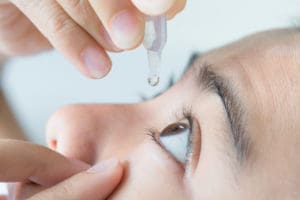CBD & the Eyes: Research & Can It Help You?
Home / How Diet Impacts Eye Health & Vision /
Last Updated:
CBD has become a touted treatment for various issues, including glaucoma. This is based on older medical studies and anecdotal reports that CBD oil, eye drops, and other forms of medical marijuana help to ease anxiety, eye strain, and eye pressure.
Table of Contents
You deserve clear vision. We can help.
The board-certified surgeons at NVISION have performed over 2.5 million procedures. Your journey to better vision starts here.
One of the first studies on medical marijuana for eye conditions involved glaucoma. This is a group of serious eye disorders associated with damage to the optic nerve, usually due to high fluid pressure in the eye, or intraocular pressure (IOP). This pressure must be lowered to prevent blindness. Further studies of medical marijuana have found that the drug does not actually lower pressure for long enough.
The United States Food and Drug Administration (FDA) has approved CBD for some very limited medical uses, and several states have legalized both medical and recreational use of marijuana, both THC and CBD.
Dispensaries recommend CBD for eye treatment, especially glaucoma. Medical research has found that medical marijuana does not lower eye pressure for more than three or four hours, which is not long enough to prevent damage to the optic nerve. Paradoxically, it may increase the risk of damage due to fluctuations in eye pressure over the course of the day.
In fact, a recent medical study found that THC, not CBD, lowered eye pressure. By itself, CBD raises IOP, and in combination with THC, it can prevent THC from lowering IOP. THC is the intoxicating, recreational chemical in marijuana, which can be addictive and cause problems with thinking or memory.
It is important for you to follow medical advice from your optometrist and ophthalmologist to manage all eye conditions, from dry eyes to glaucoma. Don’t attempt to self-treat any eye issue with CBD.
Cannabidiol (CBD) & Your Eyes: High Intraocular Pressure Is Dangerous

Glaucoma is a group of related eye conditions involving damage to the retina and optic nerve that leads to vision loss, typically due to high fluid pressure inside the eyes. Symptoms tend to start slowly until enough of the optic nerve is damaged that the person develops tunnel vision or another form of lost vision. Regular eye exams can help to diagnose glaucoma or high ocular pressure, so an optometrist or ophthalmologist can monitor this progression and ensure you receive appropriate treatment if you begin to lose your sight.
Treating glaucoma starts with medicated eye drops that are designed to lower intraocular pressure. If these do not work, there are several approaches to surgery that can lower fluid pressure in the eyes and prevent vision loss.
There are side effects to all these options, so many people with glaucoma, or who are at risk for glaucoma, want to find alternatives. One proposed alternative is CBD oil, or the cannabidiol molecule derived from medical marijuana.
Using Medical Marijuana Like CBD for Your Eyes Does Not Work
As marijuana has become more popular and many states have legalized both medical and recreational uses for this drug, CBD oil is being promoted for a range of uses, including as a glaucoma treatment.
There are very few medical studies on the effectiveness of CBD or medical marijuana, although the United States Food and Drug Administration (FDA) has information on potentially beneficial uses for this approach to treatment. They have approved one CBD-based drug for two types of severe, rare epilepsy. Some forms of medical marijuana have been examined to treat eye conditions, especially glaucoma, but newer research suggests that CBD is not an effective treatment for your eyes.
Medical marijuana has been touted to generally ease physical and emotional pain, including nausea related to cancer treatment, chronic pain, general anxiety disorder, and other conditions. In the 1970s and 1980s, medical marijuana was studied as an eye treatment, particularly for serious conditions like cataracts and glaucoma, which can lead to blindness. The research found that marijuana could lower intraocular pressure for three or four hours at a time, and it was more effective at lowering pressure in the eyes than glaucoma drops.
However, the studies also found that these pressure-lowering effects would wear off after a certain amount of time, while the effects of glaucoma eye drop treatment lasted at least 12 hours. It is vital for eye health that treatment to manage intraocular pressure lasts for a long time and is consistent. When eye pressure rises and lowers several times throughout the day, damage to the optic nerve can get worse.
Medical Studies on CBD & the Eyes Suggests CBD Is a Dangerous Chemical

CBD in particular is receiving a lot of attention from the medical community and medical marijuana proponents. However, studies suggest that the CBD compound may make intraocular pressure higher, while THC (tetrahydrocannabinol), the chemical in marijuana associated with substance abuse and getting high, is responsible for lowering eye pressure.
A study conducted in 2018 found that THC and CBD regulate eye pressure differently. When they are separated from marijuana, they will have radically different effects.
The results of the 2018 study found that a single dose of THC drops lowered IOP by 28 percent for 8 hours in male mice, although humans with glaucoma need 24-hour pressure relief to reduce damage to the optic nerve. The study also found two interesting problems. First, CBD inhibited THC from lowering IOP. Second, the effects of THC on eye pressure were sex-dependent, with male mice receiving noticeably greater benefit from the treatment.
Reported side effects of using CBD or medical marijuana for IOP included:
- Accelerated heartbeat, which can trigger anxiety or feel like anxiety.
- Decreased blood pressure overall, which can be harmful to the cardiovascular system.
- Reduced blood flow to several parts of the body, including the optic nerve, which can increase damage.
- Increased risk of lung cancer specifically from smoking or vaping marijuana products.
- Greater risk of addiction with any amount of marijuana treatment containing THC.
- Drowsiness, memory loss, and cognitive issues associated with abusing marijuana.
- Struggles to hold down a job or drive safely if drug-tested.
Most medical research suggests that CBD does not intoxicate you the same way THC does, but taking types of medical marijuana marketed as “high CBD” might mean there are traces of THC included in the substance. THC is addictive because it can change brain chemistry to make you feel relaxed, less anxious, sleepy, or even happy. The drug can also cause negative side effects like changes in mood, spikes in anxiety or paranoia, delusions, and trouble thinking or problem-solving.
Follow Your Eye Doctor’s Treatment Plan for Treating Eye Conditions
Some dispensaries hype CBD for the eyes aside from glaucoma treatment, suggesting that it can ease pain from surgery, reduce dry eye, and even alleviate eye strain. However, there are no medical studies to back up these claims. The changes to eye pressure due to CBD may lead to damage to your vision, even if you do not have glaucoma.
The only currently approved medical approach for glaucoma is regular eye exams to monitor the condition. Follow your eye doctor’s advice to manage this condition if you are diagnosed with it. This will likely mean eye drops first to prevent vision loss. It could also mean laser eye surgery, drainage devices, or other types of surgery to alleviate intraocular pressure and reduce damage to the optic nerve.
References
- Glaucoma. (July 2020). National Eye Institute (NEI).
- What You Need to Know (And What We’re Working to Find Out) About Products Containing Cannabis or Cannabis-Derived Compounds, Including CBD. (March 2020). United States Food and Drug Administration (FDA).
- Does Marijuana Help Treat Glaucoma or Other Eye Conditions? (June 2019). American Academy of Ophthalmology (AAO).
- Cannabidiol (CBD) – What We Know and What We Don’t. (August 2018). Harvard Health Publishing, Harvard Medical School.
- CBD in Marijuana May Worsen Glaucoma, Raise Eye Pressure. (December 2018). Indiana University.
- Is There a Risk of Blindness With CBD? (2018). United States Food and Drug Administration (FDA).
- Δ9-Tetrahydrocannabinol and Cannabidiol Differentially Regulate Intraocular Pressure. (December 2018). Investigate Ophthalmology & Visual Science (IOVS).
- CBD Oil May Worsen Glaucoma. (February 2019). American Academy of Ophthalmology (AAO).
- What Is Marijuana? (December 2019). National Institute on Drug Abuse (NIDA).
- Glaucoma: Management and Treatment. Cleveland Clinic.
- Eye Doctors Caution Against Using CBD as Glaucoma Remedy. (January 2019). AARP.
- Medical Management of Glaucoma: Principles and Practice. (January 2011). Indian Journal of Ophthalmology.
- How CBD May Complicate Glaucoma Treatment. (December 2018). The Fix.
This content is for informational purposes only. It may have been reviewed by a licensed physician, but is not intended to serve as a substitute for professional medical advice. Always consult your healthcare provider with any health concerns. For more, read our Privacy Policy and Editorial Policy.